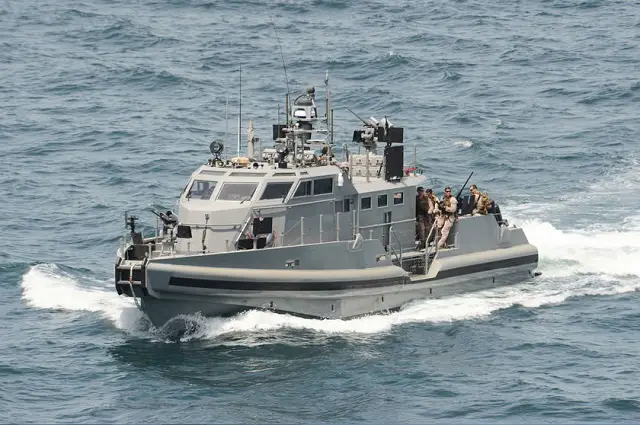Breaking news
U.S. Navy Coastal Riverine Force Tests New Coastal Command Boat in Bahrain.
| 2014
Commander
Pete Berning, U.S. Navy Coastal Riverine Force, introduces the Mark VI
Patrol Boat during Sea-Air-Space 2014. |
|||
Until
the Mark VIs get here, CTF 56 will use the CCB to prove new operating
concepts. The craft, steered by a joystick and able to top 35 knots, got
a thumbs-up from crew members on a recent trip. "It's fun to drive,"
Boatswain's Mate 2nd Class Christopher Stout said with a smile as he whipped
the boat around Manama harbor. The craft is a major step up from the Navy's riverine command boats operating in the Persian Gulf. "It has the legs and endurance to get us out into some of the blue-water areas," DiGuardo said March 28. The craft carries a crew of 10 to enable port-and-starboard watches of five Sailors with a boat captain in command - the same setup used on the RCBs. Seats on heavy-duty shock mountings are fitted for 13 SEALs in the main compartment, each with laptop connections. Video screens abound in the vessel's interior. Sound-deadening curtains separate the berthing area from the galley and an electronics space, and noise-reducing floor mats reduce machinery and water noise. A galley is fitted, along with a head and shower and five racks for crew rest. The CCB features an armored citadel enclosing the propulsion plant and fuel tanks. Numerous automatic and crew-served weapons are fitted topside, up to .50-caliber machine guns. Standoff weapons like Griffin and Spike missiles are to be tested on the vessel, DiGuardo said. When such weapons are mounted, a qualified tactical action officer will be aboard. Cradles on the fantail and a small handling crane were installed in Bahrain to handle two 800-pound mine-detection vehicles, and the vessel is intended to function as a platform for a variety of unmanned vehicles, including Puma UAVs. Small rubber rafts can be launched off the step-down stern, and divers have easy access off the fantail or on either side amidships. CTF 56 has installed the CCB on its own dock in Bahrain, and plans to operate the vessel in a variety of scenarios around the Gulf region, occasionally transporting it even farther afield. Ultimately, the CCB is to be returned to the U.S. after the Mark VIs arrive, according to Navy Expeditionary Combat Command. The 85-foot Mark VIs will be larger and, with two Mark 38 stabilized 25mm machine gun mounts, more heavily armed, designed to engage with hostile fast attack craft. After the first boat is delivered this year, three more are to follow in fiscal 2015 and two more in 2016. |
|||




























 A
Coastal Command Boat (CCB) from the Afloat Forward Staging Base (Interim)
USS Ponce (AFSB(I) 15) participates in an exercise with the amphibious
transport dock ship USS Mesa Verde (LPD 19). Mesa Verde is part of the
Bataan Amphibious Ready Group and, with the embarked 22nd Marine Expeditionary
Unit, is deployed in support of maritime security operations and theater
security cooperation efforts in the U.S. 5th Fleet area of responsibility.
(U.S. Navy photo by Mass Communication Specialist 2nd Class Shannon
M. Smith/Released)with more vessels set to follow.
A
Coastal Command Boat (CCB) from the Afloat Forward Staging Base (Interim)
USS Ponce (AFSB(I) 15) participates in an exercise with the amphibious
transport dock ship USS Mesa Verde (LPD 19). Mesa Verde is part of the
Bataan Amphibious Ready Group and, with the embarked 22nd Marine Expeditionary
Unit, is deployed in support of maritime security operations and theater
security cooperation efforts in the U.S. 5th Fleet area of responsibility.
(U.S. Navy photo by Mass Communication Specialist 2nd Class Shannon
M. Smith/Released)with more vessels set to follow.